Toyota Lease-End Options [Complete Guide]
August 10, 2021
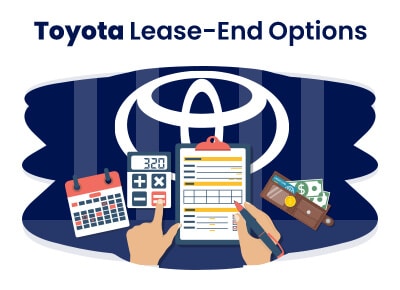

I am a serial entrepreneur and a consumer advocate. When I’m not helping car buyers, I love working on ventures that have a positive impact.
I run a cause marketing agency and serve on the board of Vayu Global Health where we are disrupting the medical industry and preventing the needless deaths of mothers and babies during childbirth.
Start preparing for the end of your Toyota lease now to avoid any unnecessary fees and complications.
As your lease-end date closes in, what do you need to do?
In this simple guide, we outline the Toyota lease-end options and what you can expect.
Compare Toyota prices & trims here >>
Table of Contents
| Toyota Lease-End Options | |
| Vehicle Inspection | |
| Return Lease | |
| Purchase Lease | |
| Return & Lease | |
| Extend Lease | |
| Lease-End Fees | $250-$400 Disposition Fee, Wear and Tear, and Excess Mileage ($0.15 - $0.25 / per mile over) |
| Lease-End Benefits | Waive disposition fee |
Option 1: Return Toyota Lease
One lease-end option is to return your Toyota without purchasing or leasing another one. If you plan to return your leased vehicle to Toyota at the conclusion of your lease you should:
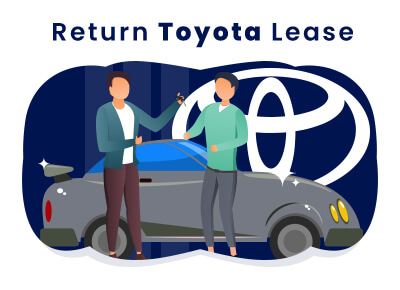 Schedule your free inspection 15-60 days prior to your lease ending.
Schedule your free inspection 15-60 days prior to your lease ending.- Complete any required repairs. Let Toyota Financial Services know when repairs are complete, and they will order another inspection for return.
- Schedule your return appointment with the originating dealer at least 30 days before lease-end.
- Bring your keys, owner’s manual, all original equipment, and the toolkit/spare tire to the inspection and return.
- When the dealer records the mileage, check and then sign the Odometer Disclosure Statement.
- You will receive a Lease End Invoice for any unpaid payments or fees. This invoice will include any charges for wear and tear, excessive mileage, etc.
- You will receive your security deposit back (it is first used to pay lease-end invoice charges)

Option 2: Purchase Toyota Lease
Another option at the end of your lease is to purchase the leased vehicle. If you choose this option, begin preparing 90 days before your lease-end. The steps for purchasing your leased vehicle include:
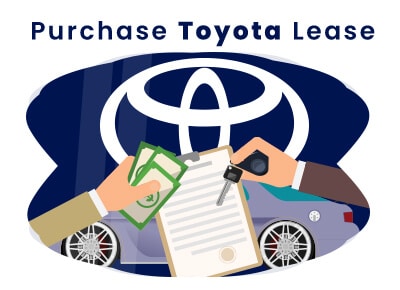 Communicate your interest in purchasing the lease with your dealership to learn more.
Communicate your interest in purchasing the lease with your dealership to learn more.- Contact Toyota at (800) 286-0652 for your payoff amount and the sale documents.
- Mail your payment and documentation to Toyota. However, some states require you to purchase the vehicle directly from the dealership.
- You do not need to have a vehicle inspection when purchasing the lease.
Option 3: Return Lease and Lease New Toyota
The final option is to return your current leased vehicle and then lease a new one. Here’s what you need to do:
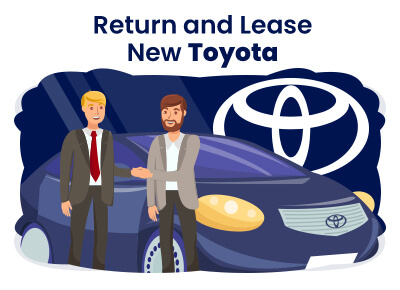 Head to Toyota.com to explore new models. Check out current Toyota deals here.
Head to Toyota.com to explore new models. Check out current Toyota deals here. - Schedule a test drive at your local dealership.
- 15-60 days before the lease-end, schedule your complimentary inspection.
- Make any necessary repairs with an approved repair shop.
- Ensure all our payments and fees are paid. Here you can cancel the recurring payments as well.
- Schedule your lease return appointment.
- Bring all original equipment and keys to the return appointment.
- Sign the Odometer Statement.
- Select your new Toyota.
- Complete your new lease and enjoy a waived disposition fee.
Option 4: Extend Toyota Lease
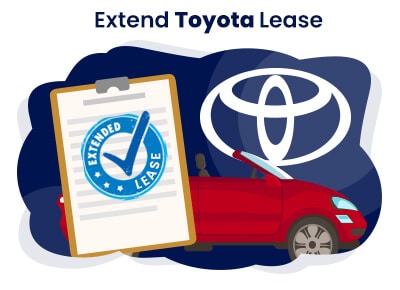 Toyota does not list lease extension as an option. Based on individual dealers, you may or may not be able to extend your lease. For example, Toyota Vacaville states that “you have three different paths you can take at the end of a Toyota lease, and, unfortunately, extending the lease is not one of them.”
Toyota does not list lease extension as an option. Based on individual dealers, you may or may not be able to extend your lease. For example, Toyota Vacaville states that “you have three different paths you can take at the end of a Toyota lease, and, unfortunately, extending the lease is not one of them.”
On the other hand, Southeast Toyota lists extension as an option for a few months. You must request a lease extension with them.
To find out about extending a lease, talk with your Toyota dealership and find out if they offer lease extensions.
Toyota Lease-End Fees
Here are the fees you may face at the end of your Toyota lease:
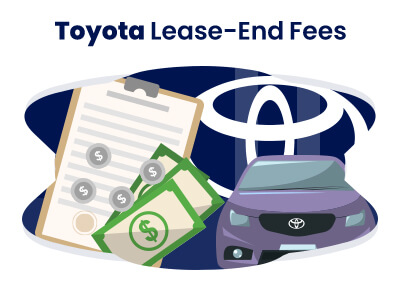
Outstanding Payments
If you have any outstanding payments, they will show up on your lease-end invoice. Your security deposit is used to pay them, and you will be responsible for any remaining balance.
Wear and Tear
Wear and tear is a normal part of driving a vehicle. Some minor wear and tear is permitted and will not result in additional charges. However, excessive wear and tear will lead to extra charges at the end of your lease. The cost of this fee depends on the extent of damage, but you may be able to find guidelines in your lease term.
Head to this Toyota guide for a breakdown of the cost of various forms of wear and tear. Also, consider the different Toyota warranty plans if you purchase the leased vehicle.
What Constitutes Wear and Tear?
Toyota created a helpful guide to explain wear and tear for leased vehicles. They recommend using a credit card as a guide to check for excess wear and tear damage.
Some examples of excessive wear and tear include:
- Dented or scratched bumper
- Broken mirrors
- Damaged windshield
- Exposed tire cord and damage to alloy wheel
- Cut seats
- Fabric burns
- Missing accessories
- Broken electronic equipment
Disposition Fee
Dealerships charge a disposition fee to recondition the vehicle and prepare it for resale upon your lease return. Disposition fees vary, but on average, you can expect between $250 and $400.
Excessive Mileage
Leases include a mileage limit, generally around 12,000 miles per year. If you exceed the allotted mileage on your lease, you must pay an excess mileage fee. On average, Toyota charges between $0.15 and $0.25 per mile over your allotted miles.
The allotted miles and the fee will be outlined in your lease. Depending on how many miles you plan to drive, it may be worth considering a high-mileage lease.
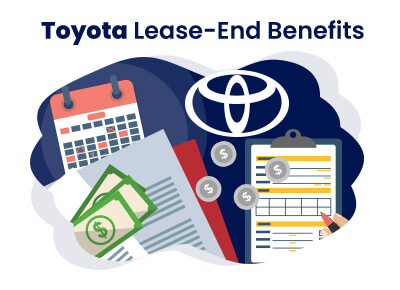
Toyota Lease-End Benefits
If you choose to lease or finance another Toyota, they will waive the disposition fee on your current lease.
To qualify, you must lease or purchase a new or Certified Used Toyota within 30 days of returning your current lease.
Frequently Asked Questions
What are my options at the end of the Toyota lease?
At the conclusion of your Toyota lease, you can return the vehicle, lease a new Toyota, or purchase your current lease. Some dealerships may allow you to extend your lease for a few months, but you must check with your dealership.
Where can I return my Toyota lease?
You must return your leased Toyota to the originating dealership. This means you can only return your Toyota lease to the dealership where you initiated the lease.
What do I need to bring with me when I return my Toyota lease?
- All sets of keys
- The owner’s manual
- Original accessories
- Toolkit and spare tire
- The Odometer Disclosure Statement
Is my residual value, purchase price, or end-of-lease fees negotiable with Toyota?
The lease terms are set at the beginning of the lease, so you will not be able to negotiate them during the lease-return process.
Can I return my Toyota lease before the lease-end date?
You can return your Toyota before the lease-end date, but you will have to pay early termination fees. Look into the alternatives to ending a lease early before doing so.
What charges am I responsible for when my Toyota lease ends?
You must pay a disposition fee to the dealership when returning your Toyota vehicle. You are also responsible for any excess wear and tear, excess mileage, and outstanding payments.
What constitutes wear and tear for Toyota?
Damage larger than the size of a credit card warrants extensive wear and tear, according to Toyota. Broken mirrors, dented bumpers, and interior burns are examples.
Posted in Car Buying Tips |








